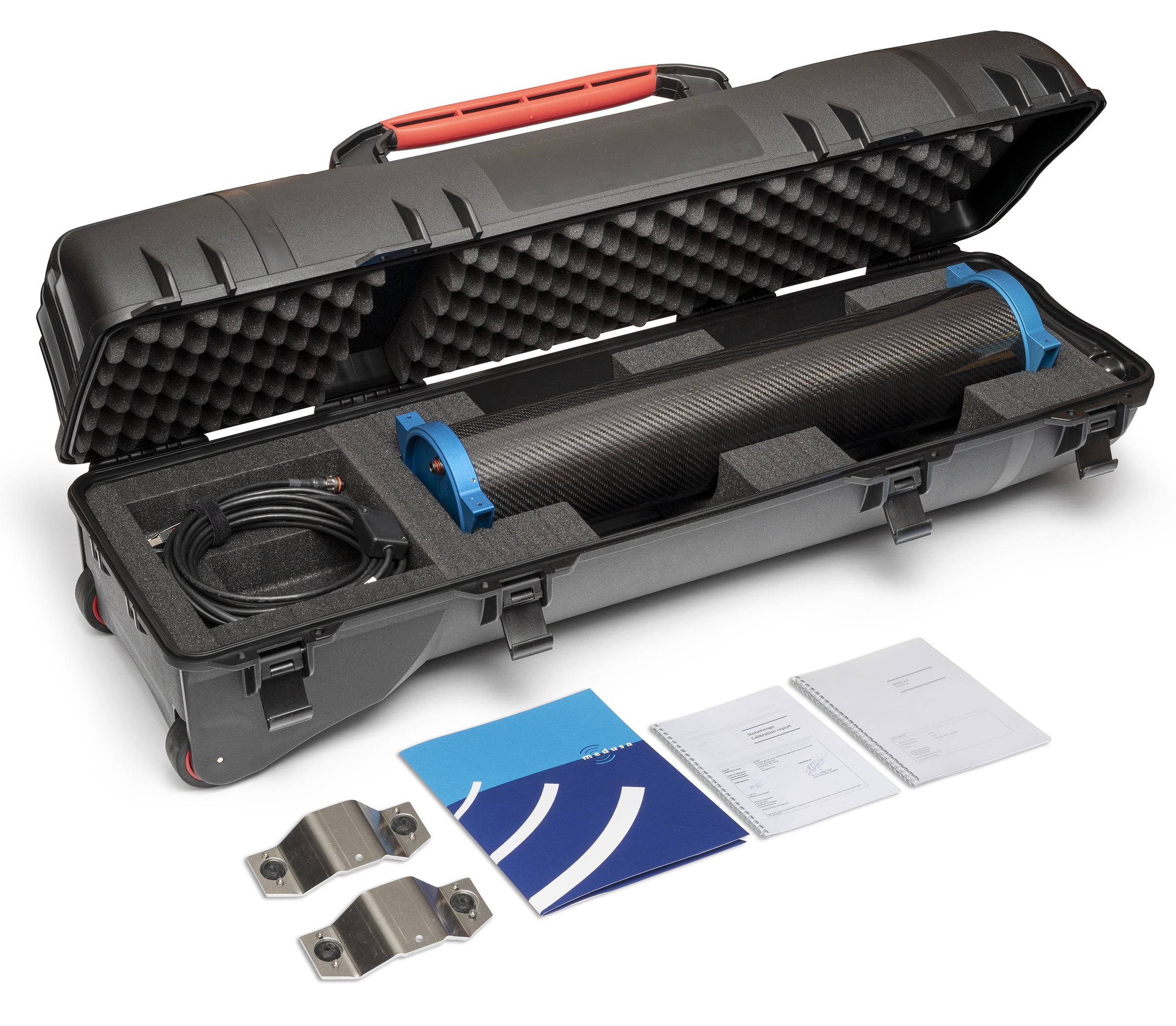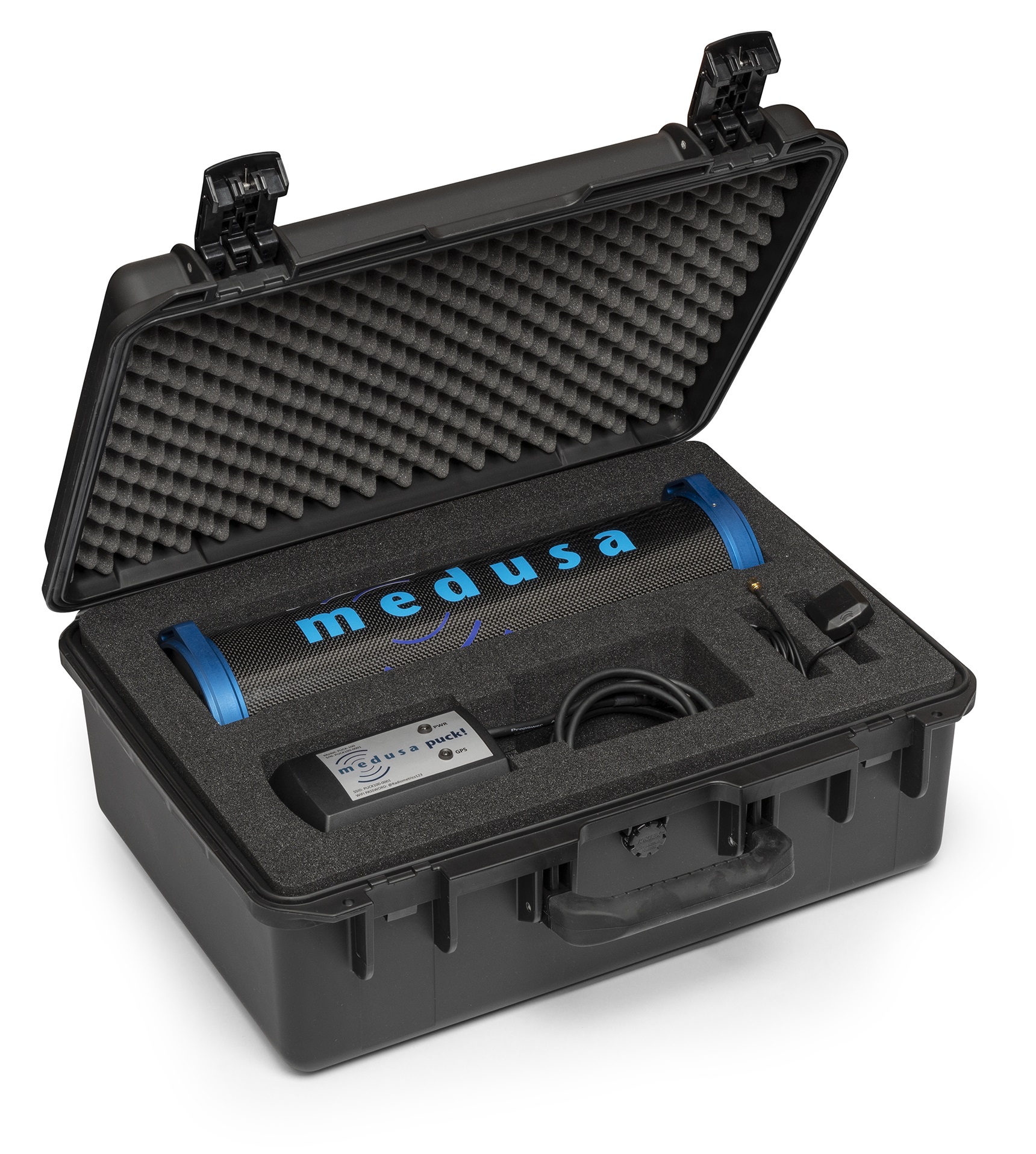Quick start
This getting started manual is intended to help you, the end-user of our system, to get up and running as quickly as possible. In other words - how to mount the spectrometer on your measurement platform, what power do you need to supply and how do you actually do a measurement.
Before starting
As a start, we would like you to note that you have a delicate instrument in your hands. Our gamma-ray spectrometers contain a (relatively) fragile scintillation crystal at their core. This crystal and the device's electronics should always be handled with care. Dropping, hitting, or significant impact on the detector may result in the breaking of this crystal. Medusa has optimised the weight of the spectrometer systems while implementing a shock-absorbing layer that keeps the crystal stable. However, improper use could still lead to the breaking of an element in the system. Therefore it is crucial that handling the detector is done with care and that proper preparation has been taken before working with this system.
UAV warning: You can use the small detectors as drone detectors. However, it is advised to confirm that the UAV platform is suitable for this weight by testing with a dummy weight. Depending on the type of UAV you are using, the weight of this detector may be at the limit of what the UAV can handle. We have had many successful measurements with our detectors. However, before mounting the real detector, we always tested the platform with a dummy. There are reports of drones that crash when carrying their maximum load. This can have various causes, among which the (weak) stiffness of the drones' frame (causing the IMUs to overcompensate) or magnetic interference (such as from little magnets incorporated in GPS antennas). Always make proper preparations when using the medusa spectrometer under a drone.
If you are in doubt about the mounting, handling or other handling issues, please get in touch with Medusa. Our support section is always happy to help you out and give advice on the use of spectrometer systems.


Mounting the detector
The end caps of the detector are equipped with mounting points. These mounting points can support the detector's weight if appropriately fastened. The dimensions and mounting points differ between the different systems. Our technical section lists all the dimensions of the various Medusa detector systems. The MS-2000 detector can be mounted by using the MSB-20x mounting brackets, whereas the smaller systems usually have an application-specific mounting.
Gamma-ray detectors, in general, are sensitive to radiation from all directions. Therefore there is no "preferred" mounting direction - a sensor can also be mounted parallel to the direction of movement as perpendicular. Gamma radiation is, attenuated by materials placed between the detector and the source of the radiation. Therefore the detector should be mounted so that there is the least possible obstruction between the source (the soil) and the sensor.
More information and examples of mounting the spectrometer on a platform can be found on the Theory page.
Powering the device
Medusa supplies the systems with a variety of cables that are specifically tailored for each application. Information on the specifications of all available cables can be found in the Cables and connectors section. The table below lists which cables come standard with each detector type. Always use medusa certified cables on the system; these cables are specifically designed to be used with our spectrometer systems.
| Detector | Cable | Input voltage range | Connectors |
|---|---|---|---|
| MS-4000/MS-2000 | MDC-40x cable | 9-18 or 9-35V | Ethernet and flying leads for power |
| MS-1000-/MS-700/MS-350 | MDC-50x cable | 3-35V | USB for power |
Spectrometers have a nominal power usage of 3W and a peak power usage of 6W.
Configuring the measurement
When the system is powered, it will automatically start the spectrometer. All data is logged and automatically saved to the project which was active before.
System startup
The detector has four LEDs embedded in the top cap. The orientation of the LEDs relative to the connector depends on the detector series. Some detectors are mounted with the fastening wings down, such as the MS-2000, and some are mounted with the fastening wings up, such as the MS-350 or the MS-1000. The position described below is with the connector oriented below the LEDs. The table below lists the colour coding for the mDOS V3.0 systems.
| Name | Colour | Function |
|---|---|---|
| PWR | Green | Power is ok and in the right input range |
| Red | Power is too low or high | |
| Purple | Power line has large fluctuations, please check the power supply | |
| ETH | Green | Ethernet cable is connected |
| SCN | Green | This LED will blink if a spectrum is collected. |
| AUX | Green | This LED will blink if auxiliary sensor data is received (GPS, PTH, etc.) |
If both the SCN and AUX LEDs blink in red, this means that the internal storage is almost full. The default action when all storage space is taken is to overwrite the oldest data! At a typical data logging rate of 1Hz and storage capability of 4GB this means that you can store around 20 days of data.
Accessing the mDOS interface through the built-in website
When an ethernet cable is connected
The detector can be accessed either by directly connecting the detector to a computer or by connecting it to a network using a router. The detector will check if it receives an IP address from a router. If no IP address is provided by your router, e.g. when the detector is connected directly to a computer, the detector will initialize with its default IP address. If a router in the network provides the detector with an IP address, this address must be determined by checking the router settings. Most routers can set a unique IP address based on the connected device. Detectors in the network can also be found using the Medusa detector finder tool, which can be downloaded from the Medusa Software section under software downloads and updates.
Additionally, if your network supports multicast DNS (mDNS), the detector can be accessed by using the detector hostname.
To access the built-in website, navigate to the IP address.
| Setting | Description | Example |
|---|---|---|
| Standard IP-address | 192.168.2.150 | |
| Hostname | <Model>-<Series number>.local | MS-2000-0054.local |
| Webserver | <IPaddress> | 192.168.2.150 |
When the detector is connected directly to the computer by using the ethernet cable, the website of your detector can be accessed by navigating to the address: 192.168.2.150:8000 (mDOS V2) or 192.168.2.150:3333 (mDOS V3)
Through WIFI
Connecting your computer, tablet or phone to the detectors network makes it possible to access the web server through its standard IP address as described in the section above.
| Setting | Description Internal puck (PUCK-300) |
|---|---|
| Detector SSID | MS<version>-<serial> |
| Detector password | @Radiometrics123 |
| Webserver | 192.168.3.1 |
The landing page of the web-interface
Selecting or downloading a project
When connected to the interface, inspect the measurement through the available pages. The project page gives basic information on the current measurement and selected project.
Project management (projects page)
New projects can be created, or old projects can be selected or deleted. Selecting means that data will be logged into this project. Deletion of the project is permanent and cannot be undone.
When the option "overwrite oldest files when full" is selected measurement system will overwrite the oldest files.
Starting a measurement
After selecting a project, the measurement is started. Because the spectrometer is designed to be "always on", the data is stored automatically on the device. Once a project has been created, all data is subsequently logged to this project. The Medusa Gamman software provides the tools to make selections on the project. This can be done either by timestamp or by geometric position.
It can be confirmed that the measurement is still running by checking the LEDs during the measurement. The SCN LED will blink for every stored spectrum, and the AUX LED will blink for every auxiliary data entry.
Retrieving the data
After the measurement or during measurement, you can download the recorded data from the device. This must be done through the web interface by navigating to the projects page. A project can be downloaded by clicking on the project name and then using the download button. When downloading a project, it will be compressed to a .zip file before sending it to the user. A progress bar shows the progress of the compression. Once this is finished, a pop-up will appear with the project file. You can now save the data to your PC or other devices. When a phone or tablet is used, the user should remember that all data needs to be transferred to a (Windows) computer where the data can be analysed using GAMMAN or other software.
Turning the device off
Restarting the system can either be done by pressing the button in the web server or by power cycling the system. Powering down the system is done by simply removing the power.
